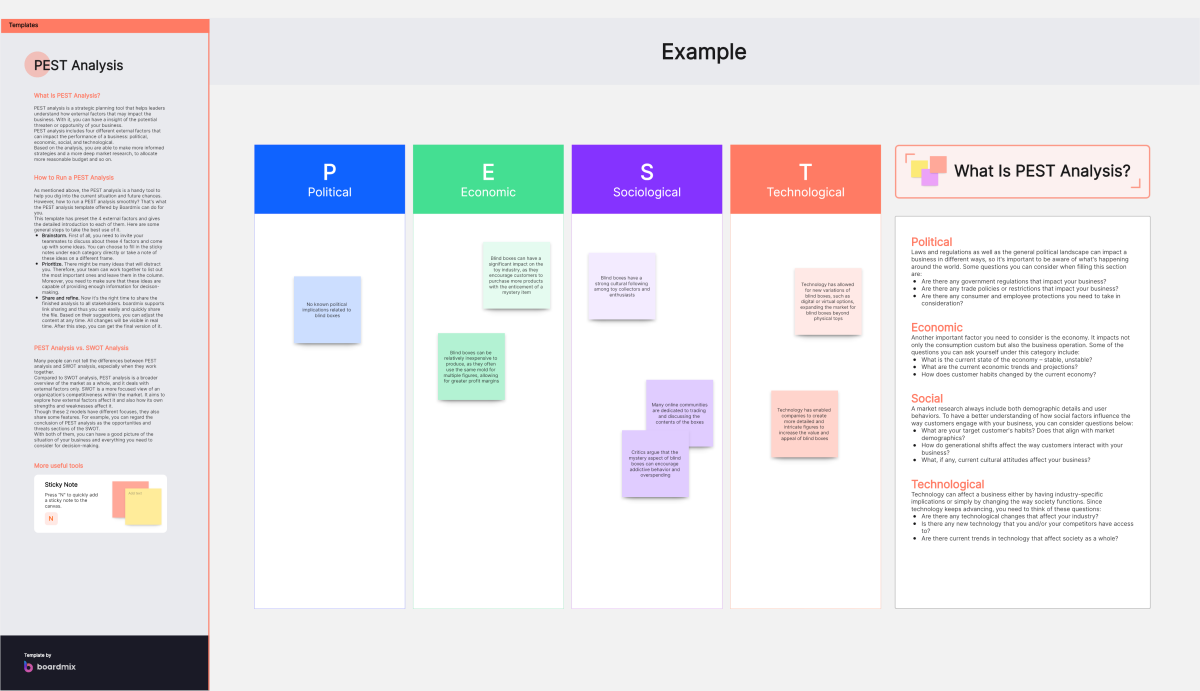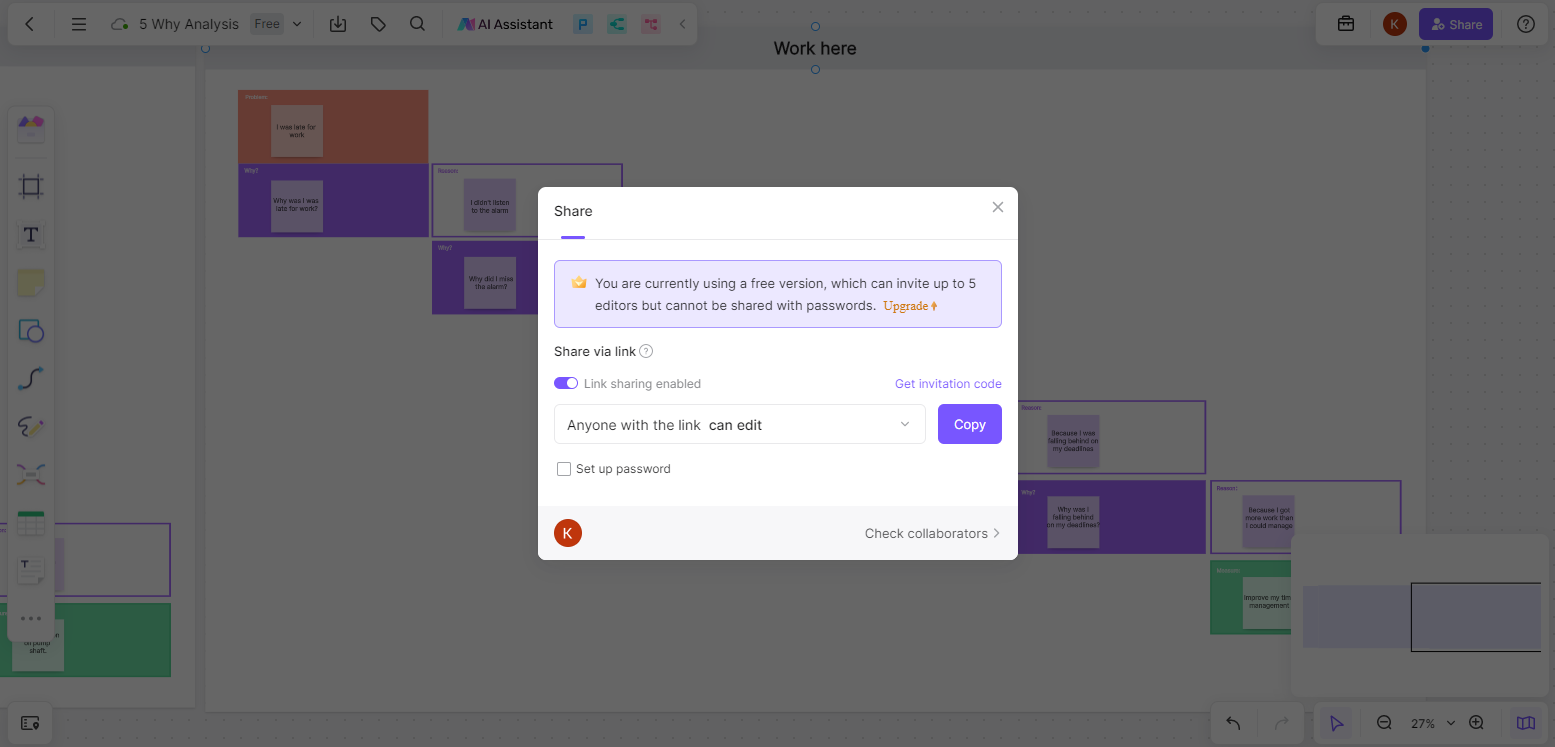PEST Analysis is a fundamental strategic planning tool used to evaluate the external macro-environmental factors that can impact a business's operations and performance. By examining Political, Economic, Social, and Technological aspects, businesses can identify opportunities for growth and potential threats to their success. In this article, we will explore ten diverse examples of PEST Analysis across various industries, followed by free templates from Boardmix that you can use to conduct your own analysis.

Part 1: PEST Analysis Examples
These examples illustrate how a PEST Analysis can be applied across various industries. Let’s learn how to they work.
1. Fast Food Industry
- Political: Health regulations, zoning laws, and trade agreements affecting ingredient sourcing.
- Economic: Consumer spending power, inflation rates, and economic cycles.
- Social: Health consciousness, changing dietary preferences, and demand for sustainability.
- Technological: Online ordering systems, mobile apps, and automation in food preparation.
2. Renewable Energy Sector
- Political: Government subsidies, environmental regulations, and renewable energy mandates.
- Economic: Global energy prices, investment in green technologies, and cost of renewable infrastructure.
- Social: Public awareness of climate change, demand for clean energy, and societal support for sustainability initiatives.
- Technological: Advancements in solar, wind, and hydroelectric technologies, and energy storage solutions.
3. Fashion Retail
- Political: Import/export tariffs, labor laws, and environmental regulations on textiles.
- Economic: Consumer disposable income, global economic trends, and currency exchange rates.
- Social: Fashion trends, consumer attitudes towards fast fashion, and ethical consumerism.
- Technological: E-commerce platforms, virtual fitting rooms, and supply chain management software.
4. Real Estate Market
- Political: Zoning laws, property tax rates, and urban development policies.
- Economic: Interest rates, mortgage availability, and economic growth indicators.
- Social: Population growth, urbanization trends, and demographic shifts.
- Technological: Property listing platforms, virtual tours, and smart home technologies.
5. Pharmaceutical Industry
- Political: Intellectual property laws, FDA regulations, and healthcare policy changes.
- Economic: R&D funding, healthcare spending, and global market demand for pharmaceuticals.
- Social: Aging populations, public health awareness, and demand for generic drugs.
- Technological: Biotechnology advancements, digital health records, and telemedicine.
6. Automotive Industry
- Political: Emission standards, fuel efficiency regulations, and trade policies.
- Economic: Consumer credit availability, oil prices, and economic growth rates.
- Social: Consumer preferences for electric and hybrid vehicles, urbanization, and car-sharing trends.
- Technological: Autonomous driving technology, electric vehicle infrastructure, and connected car systems.
7. Education Sector
- Political: Education policies, funding for public and private institutions, and visa regulations for international students.
- Economic: Tuition fees, student loan availability, and the economic value of education.
- Social: Demographic shifts in student populations, lifelong learning trends, and the rise of online education.
- Technological: Learning management systems, educational technology (EdTech), and virtual classrooms.
8. Tourism and Hospitality
- Political: Travel restrictions, visa policies, and government support for tourism.
- Economic: Economic stability, exchange rates, and disposable income for travel.
- Social: Traveler preferences, cultural exchange, and environmental impact considerations.
- Technological: Online booking platforms, virtual reality experiences, and smart hotel technologies.
9. Banking and Financial Services
- Political: Financial regulations, anti-money laundering laws, and central bank policies.
- Economic: Interest rates, inflation, and economic growth affecting investment and lending.
- Social: Consumer trust in financial institutions, financial literacy, and demand for digital banking services.
- Technological: Blockchain, cybersecurity, and mobile payment systems.
10. Technology Startups
- Political: Intellectual property rights, data privacy laws, and government support for startups.
- Economic: Venture capital availability, market demand for innovative technologies, and global economic conditions.
- Social: Workforce skills, cultural acceptance of new technologies, and the gig economy.
- Technological: Rapid technological advancements, the rise of artificial intelligence, and the Internet of Things (IoT).
Part 2: Free PEST Analysis Template in Boardmix
Boardmix offers many great features that make it an ideal choice for conducting a PEST analysis, including its user-friendly interface, customization options, real-time collaboration capabilities, note-taking functionality, and exporting capabilities, which ensure a comprehensive and efficient analysis process. To help you conduct your own PEST Analysis, here is the free PEST analysis template that you can download and customize.
Steps for Creating a PEST Analysis in Boardmix
Creating a PEST analysis in Boardmix is a straightforward process. Here are the steps to follow:
1. Sign in or create an account: Visit the Boardmix website and sign in with your existing account or create a new one if you don't have an account yet.

2. Create a new whiteboard: Once you're signed in, click on the "New Whiteboard" button to start creating a new whiteboard for your PEST analysis.

3. Add PEST analysis template: In the whiteboard, click on the "Templates" option in the toolbar and search for "PEST analysis." Select the template that suits your needs and click on it to add it to your whiteboard.

4. Customize the template: Customize the PEST analysis template by adding your own content and data. You can edit the text, add or remove sections, and rearrange elements according to your analysis requirements.
- Analyze political factors: Start by analyzing the political factors that may impact your business or industry. Add relevant information, such as government regulations, political stability, and international relations.
- Analyze economic factors: Move on to analyzing the economic factors that can influence your business. Consider factors like economic growth, inflation rates, exchange rates, and consumer purchasing power.
- Analyze social factors: Next, analyze the social factors that may affect your business. This includes demographic trends, cultural influences, consumer attitudes, and social values.
- Analyze technological factors: Finally, analyze the technological factors that can impact your business. Consider advancements in technology, innovation trends, and digitalization efforts within your industry.

5. Collaborate and gather input: If you're working with a team or stakeholders, use the collaboration features of Boardmix to gather input and insights from others. You can invite team members to join your whiteboard and collaborate in real-time.
6. Add notes, comments, and images: Enhance your analysis by adding notes, comments, and images to provide further context and explanations for your findings. This will make your analysis more comprehensive and informative.
7. Export and share: Once your PEST analysis is complete, you can export it in various formats such as PDF or PNG. This allows you to easily share your analysis with colleagues, clients, or other stakeholders.

That's it! You have successfully created a PEST analysis in Boardmix. Enjoy exploring and analyzing the external factors that may impact your business or industry.
Instructions for Using the PEST Analysis Template
1. Identify the Business or Project: Clearly define the business or project you are analyzing.
2. Fill in the Political, Economic, Social, and Technological Factors: Based on your research, list and describe the factors that could impact your business.
3. Analyze the Impact: For each factor, assess how it could positively or negatively affect your business.
4. Identify Opportunities and Threats: Use the analysis to pinpoint potential opportunities for growth and areas of risk.
5. Develop Strategies: Based on your findings, outline strategies to capitalize on opportunities and mitigate threats.
Conclusion
PEST Analysis is a versatile tool that can be applied across various industries to gain insights into the external factors that can influence business decisions. The ten examples provided illustrate the diverse applications of PEST Analysis, and the free template offers a convenient starting point for your own strategic planning. By regularly conducting PEST Analysis, businesses can stay agile, anticipate changes, and maintain a competitive edge in the market.
This article offers a comprehensive look at PEST Analysis, providing real-world examples and free templates from Boardmixd for readers to apply this strategic tool to their own businesses. By understanding and analyzing the Political, Economic, Social, and Technological factors, businesses can make informed decisions that drive growth and success.













